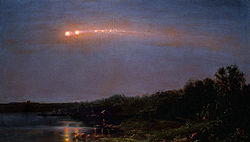어스그레이징 유성

어스그레이징 유성(Earth-grazing fireball) 또는 어스그레이저(Earth-grazer)[2]는 지구 대기권으로 접근했다 다시 우주로 떠나는 매우 밝은 유성을 만드는 유성체이다. 이 때 유성체가 지구 대기권을 통과하면서 폭발하거나 쪼개져 파편들이 지구로 낙하해 운석이 될 수도 있다. 이렇게 될 경우, 이 유성체들을 어스그레이징 유성집단(Meteor procession)이나 화구라고 부른다.[1] 어스그레이징 유성의 가장 대표적인 예시로는 1972년 8월 10일 대화구와 1860년 7월 20일 대유성이 있다.[1][3][4]
개요
[편집]어스그레이징 유성들은 지구 대기권을 통과하며 속도와 질량이 변하기 때문에, 대기 밖으로 나갈 때 유성의 궤도는 처음 지구 대기권에 진입했을 때와는 꽤 많이 달라진다.[5][6][7]
지구 대기권의 높이가 어느정도까지인지에 대해서는 합의된 바가 없다. 성층권(~50 km), 중간권(~85 km), 열권(~690 km), 외기권(~10,000 km, 열권계면) 등으로 나눠져서 위로 올라갈수록 대기가 희박해지긴 하나 각 권간의 경계는 분명하지 않다. 예를 들어, 유성체는 지구에서 고도 85-120nbsp;km 고도에서 유성이 될 수 있다.
알려진 어스그레이징 유성
[편집]
어스그레이징 유성이 관측되는 경우는 매우 드물다.[8] 이는 유성체가 지구 대기권으로 접근하며 지구와 충돌하지 않고 대기권에 빠져나갈 때까지 충격파를 견뎌야 하기 때문이다. 2008년까지, 근대적 천체 관측 이후 총 4건의 어스그레이징 유성이 관측되었다.[9]
- 1860년 7월 20일 대유성[1][3][4]
- 1913년 2월 9일 대유성 - 일시적으로 지구의 자연위성이 되었으나 결국은 파괴되었다.[10]
- 1972년 8월 10일 대낮 대화구 - US19720810라고도 부르며, 15 km/s의 속도로 미국, 캐나다 상공을 지나쳤다.(최초의 근대적 천체 관측)
- 1990년 10월 13일 어스그레이징 유성 - 40kg의 유성체가 41.5 km/s의 속도로 체코슬로바키아 상공을 지나쳤다.(먼 거리의 서로 다른 두 지점에서 촬영한 사진을 바탕으로 궤도를 계산한 최초의 사례)[7]
- 2006년 3월 29일 대유성 - 유성체가 18.8 km/s의 속도로 일본 상공 71.4 km 고도를 지나쳤다.[11][12]
- 2007년 8월 7일, EN070807이 유럽 상공을 지나쳤다. 희귀한 아텐 소행성이 지나친 것으로 확인되었다.[8][13]
- 2012년 6월 10일, ζ-페르세우스자리 유성군 중 일부가 대기권으로 진입하여 스페인 상공을 통과했으며 지구 대기권 510km을 일주했다. 이 유성은 가장 희미했던 어스그레이징 유성으로 논문으로만 보고되었으며 최초의 어스그레이징 유성우에 속한다.[14]
- 2014년 12월 24일, 크리스마스 이브에 SPMN241214가 천천히 북아프리카, 에스파냐, 포르투갈 상공을 통과하여 대기권을 1,200km 유영했다.[15]
- 2017년 7월 7일 데저트 파이어볼 네트워크가 오스트레일리아 서부와 남부를 관통하며 1,300 km 가량 지구 대기를 통과한 유성을 관측했다. 가장 낮게 접근한 고도는 58.5 km이며 유성체의 무게는 ~60 kg로 추정되었다.[16]
같이 보기
[편집]각주
[편집]- ↑ 가 나 다 라 “Texas State astronomers solve Walt Whitman meteor mystery : University News Service : Texas State University”. Txstate.edu. 2010년 5월 28일. 2011년 10월 19일에 원본 문서에서 보존된 문서. 2017년 4월 28일에 확인함.
- ↑ Nemiroff, R.; Bonnell, J., eds (2009년 3월 2일). “Earthgrazer: The Great Daylight Fireball of 1972”. 《Astronomy Picture of the Day》. NASA. 2017년 4월 28일에 확인함.
- ↑ 가 나 Images of Harper's Weekly front page story
- ↑ 가 나 “150-year-old meteor mystery solved”. 2010년 6월 5일에 원본 문서에서 보존된 문서. 2017년 4월 28일에 확인함.
- ↑ US19720810 (Daylight Earth grazer) 보관됨 3월 7, 2004 - 웨이백 머신 Global Superbolic Network Archive, 2000, 'Size: 5 to 10 m'
- ↑ Daylight Fireball of August 10, 1972 C. Kronberg, Munich Astro Archive, archived summary by Gary W. Kronk of early analysis and of Zdeněk Ceplecha's paper for Astronomy and Astrophysics in 1994, '3 meters, if a carbonaceous chondrite, or as large as 14 meters, if composed of cometary materials', 'post-encounter ... 2 or 10 meters'
- ↑ 가 나 Spurný, P.; Ceplecha, Z.; Borovicka, J. Earth-grazing fireball: Czechoslovakia, Poland, October 13, 1990, 03h27m16sUT. WGN, Vol. 19, Nr. 1, p. 13; (aphelion of its orbit changed from 2.80 AU to 1.80 AU)
- ↑ 가 나 Spurný, P. Spurný; J. Borovička; Z. Ceplecha; L. Shrbený (2008년). “Precise Multi-instrument Data on 45 Fireballs Recorded over Central Europe in the Period 2006-2008” (PDF). 《Asteroids, Comets, Meteors》 (체코: Astronomical Institute of the Academy of Sciences, Fričova 298, CZ-251 65 Ondřejov Observatory). 2017년 4월 28일에 확인함.
EN070807 fireball ... very rare Earth-grazing fireball ... Aten type
- ↑ Although other grazers have been seen and, rarely, photographed, without specialised scientific observations their orbits cannot be determined. An example is the Leonid grazer over Hawaii on 2001-11-18 -Abe 2006 (PDF)
- ↑ O'Keefe, John A. 1959. A Probable Natural Satellite: The Meteor procession of February 9, 1913. Journal of the Royal Astronomical Society of Canada, Vol. 53, p.59. Code 1959JRASC..53...59O. Retrieved 2008-07-07
- ↑ Abe 2006 (abstract)
- ↑ Abe 2006 (PDF) approximately 100 kg, orbit aphelion reaches Jupiter
- ↑ EN indicates the European Fireball Network
- ↑ Madiedo, José M.; Espartero, Francisco; Castro-Tirado, Alberto J.; Pastor, Sensi; de los Reyes, José A. (2016년 5월 1일). “An Earth-grazing fireball from the Daytime ζ-Perseid shower observed over Spain on 2012 June 10” (PDF). 《Monthly Notices of the Royal Astronomical Society》 460 (1): 917–922. arXiv:1604.08380. Bibcode:2016MNRAS.460..917M. doi:10.1093/mnras/stw1020.
- ↑ Moreno, A.; Madiedo, J. M.; Zamorano, J.; 외. (2016년 3월). 〈Preliminary Spectroscopic and Dynamical Analysis of an Earth-Grazer Fireball Observed on December 24, 2014〉 (PDF). 《47th Lunar and Planetary Science Conference, held March 21-25, 2016 at The Woodlands, Texas》. 1088쪽. Bibcode:2016LPI....47.1088M.
- ↑ Shober, Patrick M.; Jansen-Sturgeon, Trent; Sansom, Eleanor K.; Devillepoix, Hadrien A. R.; Towner, Martin C.; Bland, Phil A.; Cupák, Martin; Howie, Robert M.; Hartig, Benjamin A. D. (2020). “Where Did They Come from, Where Did They Go: Grazing Fireballs”. 《The Astronomical Journal》 159 (5): 191. arXiv:1912.01895. Bibcode:2020AJ....159..191S. doi:10.3847/1538-3881/ab8002. S2CID 208617451.
외부 링크
[편집]- Fireball of 1860 (회화)
- Fireball of 1972 (사진)